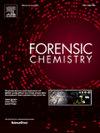Water we waiting for? Evaluating a greener, safer, more cost-effective strategy for applying 1,2-indanedione to fingermarks on paper
IF 2.6
3区 医学
Q2 CHEMISTRY, ANALYTICAL
引用次数: 0
Abstract
Developing fingermarks on paper-based evidence with 1,2-indanedione and zinc chloride is a fundamental evidence gathering methodology; however, the most widely-used carrier solvents to effect it, HFE-7100, will be phased out after 2025, necessitating new 1,2-indanedione formulations. While flammable hydrocarbon solvents have been suggested as suitable replacements for HFE-7100, the compromise to safety makes them unappealing long-term alternatives. This work evaluates a fundamentally different approach; a water-based, non-flammable xanthan gum gel medium hosting 1,2-indanedione that allows for detection of natural fingermarks. The optimised xanthan gum hydrogel formulation preserved fingermark ridge detail whereas the equivalent free-flowing ethanol/water-based solution did not. A natural fingermark depletion study demonstrated that hydrogels could be effective on simulated casework evidence, particularly 24 h after gel application. A validation study (n = 1920) comparing the 1,2-indanedione hydrogel formulation against a petroleum ether formulation found that, while the latter retained significantly better performance at this early stage of development, from a holistic frugal forensics perspective, hydrogels offer major benefits to cost and safety. This work also identified that refining the gel application method will likely improve the gel's performance, which will guide further development to deliver a safer, longer-term alternative to HFE-7100.

我们在等水吗?评估一种更环保、更安全、更具成本效益的将1,2-茚二酮应用于纸上手印的策略
用1,2-茚二酮和氯化锌在纸质证据上形成手印是一种基本的证据收集方法;然而,最广泛使用的载体溶剂HFE-7100将在2025年后逐步淘汰,因此需要新的1,2-茚二酮配方。虽然可燃碳氢化合物溶剂被认为是HFE-7100的合适替代品,但安全性的妥协使它们不具有长期替代品的吸引力。这项工作评估了一种完全不同的方法;一种水基、不可燃黄原胶凝胶介质,含有1,2-茚二酮,可用于检测天然手印。优化的黄原胶水凝胶配方保留了手印脊的细节,而等效的自由流动的乙醇/水基溶液则没有。一项天然手印去除研究表明,水凝胶在模拟案例证据中是有效的,特别是在凝胶应用后24小时。一项验证研究(n = 1920)将1,2-茚二酮水凝胶配方与石油醚配方进行了比较,发现后者在开发的早期阶段保留了明显更好的性能,但从整体节约取证的角度来看,水凝胶在成本和安全性方面具有重大优势。这项工作还发现,改进凝胶应用方法可能会提高凝胶的性能,这将指导进一步开发出一种更安全、更长期的替代HFE-7100的产品。
本文章由计算机程序翻译,如有差异,请以英文原文为准。
求助全文
约1分钟内获得全文
求助全文
来源期刊

Forensic Chemistry
CHEMISTRY, ANALYTICAL-
CiteScore
5.70
自引率
14.80%
发文量
65
审稿时长
46 days
期刊介绍:
Forensic Chemistry publishes high quality manuscripts focusing on the theory, research and application of any chemical science to forensic analysis. The scope of the journal includes fundamental advancements that result in a better understanding of the evidentiary significance derived from the physical and chemical analysis of materials. The scope of Forensic Chemistry will also include the application and or development of any molecular and atomic spectrochemical technique, electrochemical techniques, sensors, surface characterization techniques, mass spectrometry, nuclear magnetic resonance, chemometrics and statistics, and separation sciences (e.g. chromatography) that provide insight into the forensic analysis of materials. Evidential topics of interest to the journal include, but are not limited to, fingerprint analysis, drug analysis, ignitable liquid residue analysis, explosives detection and analysis, the characterization and comparison of trace evidence (glass, fibers, paints and polymers, tapes, soils and other materials), ink and paper analysis, gunshot residue analysis, synthetic pathways for drugs, toxicology and the analysis and chemistry associated with the components of fingermarks. The journal is particularly interested in receiving manuscripts that report advances in the forensic interpretation of chemical evidence. Technology Readiness Level: When submitting an article to Forensic Chemistry, all authors will be asked to self-assign a Technology Readiness Level (TRL) to their article. The purpose of the TRL system is to help readers understand the level of maturity of an idea or method, to help track the evolution of readiness of a given technique or method, and to help filter published articles by the expected ease of implementation in an operation setting within a crime lab.
 求助内容:
求助内容: 应助结果提醒方式:
应助结果提醒方式:


